The U.S. retaliatory drone strike in Kabul against ISIS-K reminds Ann Wright of her personal experience in helping to relocate large numbers of people in short order from Freetown, Sierra Leone, 25 years ago.
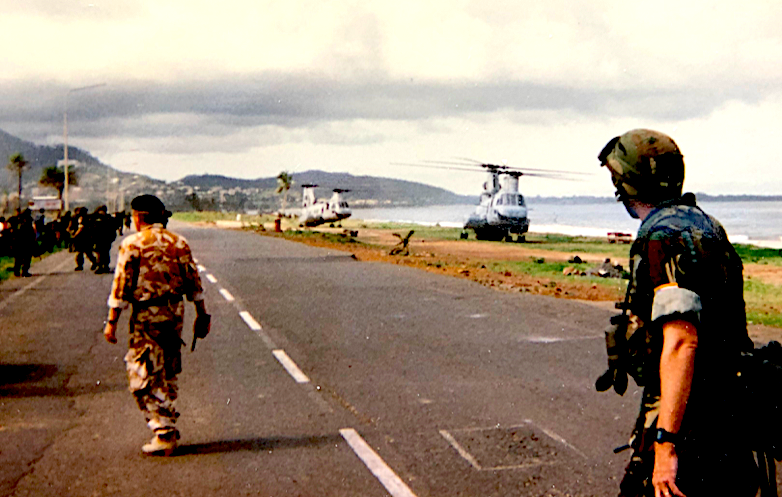
Helicopters at the evacuation site in Freeport, Sierra Leone, 1997. (U.S. Navy)
By Ann Wright
Special to Consortium News
 Evacuations of American citizens from crisis countries is always difficult and dangerous, as the recent evacuation of over 124,000 people from Afghanistan demonstrated.
Evacuations of American citizens from crisis countries is always difficult and dangerous, as the recent evacuation of over 124,000 people from Afghanistan demonstrated.
Twenty five years ago, in late May 1997, I was involved in the evacuation of 2,500 people from a violent coup in the West African country of Sierra Leone. I’m writing this detailed description of what happened then to provide some context and comparison with the massive evacuation conducted in Afghanistan, during which, on Aug. 26, an ISIS-K suicide bomber at the Abby gate of the Kabul international airport detonated a huge amount of explosives on his body that killed over 170 Afghans and 13 members of the U.S. military.
The subsequent retaliatory U.S. drone strike in Kabul against ISIS-K reminded me of an incident during our 1997 evacuation from Freetown, Sierra Leone, and the violence — potential or actual — that can occur during these military operations.
The Freetown Coup
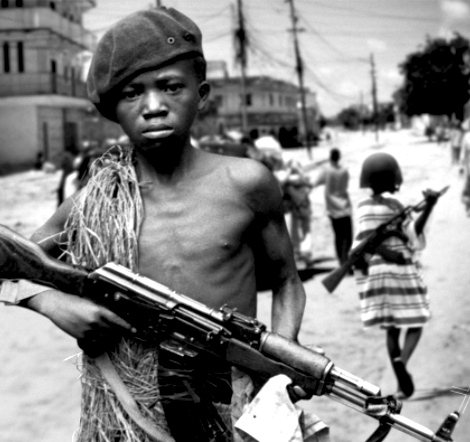
Child soldiers in Sierra Leone. (Centre International pour la Paix et les Droits de l’Homme, freshcomp15.blogspot.com)
First, some background on the coup in Freetown: On May 25, 1997, hundreds of members of the brutal Revolutionary United Front (RUF) had come into the capital city under cover of darkness as parts of Sierra Leone’s military decided to join forces to overthrow the elected government.
The RUF had been terrorizing villages in the countryside for several years. They burned houses, forced children to watch as their parents and siblings were raped and murdered in front of them. Some kids were forced to hold machetes that were used to kill their own family members. If family members were not killed, they were severely injured by machete chops that cut off hands, arms, legs, ears or noses. Victims were asked, “Do you want a long sleeve or short sleeve?” And accordingly, RUF terrorists would chop off the arm at the wrist or above the elbow.
The RUF kidnapped many of the children, forced them to take drugs and to become soldiers. Many kids carried/dragged rifles as tall as they were. Drugs were taken orally or rubbed into open cuts with gunpowder added “to increase” the effectiveness of the drugs. This method was a form of poisoning that had further negative mental consequences for the children.
After the fall of the coup government a year later, these mental issues had to be addressed by the organizations that tried to deprogram the brigade of child soldiers who were taken from the RUF.
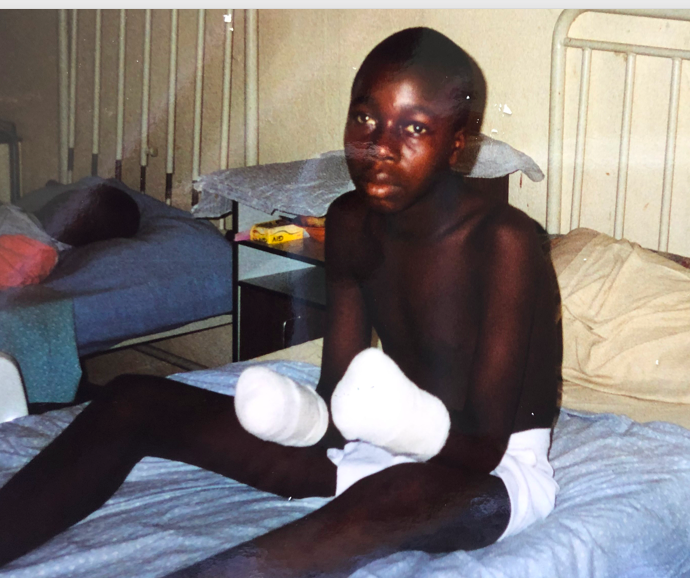
Sierra Leonean boy in Connaught Hospital in Freetown in April 1997. His hands were chopped off by the RUF rebels. (Ann Wright)
As in Sierra Leone, drug usage has been a major problem in Afghanistan. There are reports of some of the Taliban appearing to be high on drugs at checkpoints and the Afghan national army had problems with drug usage within its ranks.
Despite the U.S. government spending almost $9 billion on drug eradication in the 19 years since 2002, poppy production increased each year of the U.S. occupation. Afghanistan is the world’s largest producer of opium with annual exports of between $1.5 and $3 billion, according to the 2018 report of the Special Inspector General for Afghanistan Reconstruction.
Diplomatic Effort
During the coup in Sierra Leone, I was the acting head of the U.S. embassy as our ambassador had just left for a well-deserved vacation in the U.S. As chargé d’affaires, I was responsible for getting our small team coordinated to keep Washington informed of events and to protect our embassy personnel and U.S. citizens to the extent possible.
Our diplomatic security officer kept me abreast of what he was hearing from local police. Our consular and administrative officers kept track of American citizens, friends and contacts in the Sierra Leonean community. Our local staff were key to understanding the breadth of the coup as they were in touch with friends and family members throughout the capital city and in the provinces.
Two days after the coup began, I participated in attempt to persuade the military head of the Armed Forces Revolutionary Council (AFRC), who was the public face of the coup, into backing down. I joined British High Commissioner Peter Penfold and Berhanu Dinka, head of the United Nations mission in Sierra Leone.
We held one meeting outside the home of the British high commissioner. We had with us the 13-person U.S. Special Forces team that had been conducting a small unit training program with one battalion of the Sierra Leonean military. (Neither the U.S. military team nor the British nor Nigerian military teams that had come into the country to provide various aspects of military training were involved in the coup.)
We told the coup makers that the international community was not going to recognize the coup and that, with the agreement of the elected government, we could assist the coup makers in brokering a deal for an amnesty if they would back down. A similar strategy had been successful during a previous coup in Sierra Leone, during which a senior coup-maker agreed to college education outside the country.
In our meeting, I also told the coup makers that a very large U.S. Navy ship was a few miles off the coast and that we would be flying evacuees to the ship. The U.S. military also had fighter jets and armed helicopters that would be used to deter any effort to stop the evacuation.
We also said that we expected the AFRC to allow the passage of evacuees onto the peninsula where we were conducting the evacuation from a hotel that had a helicopter pad and was used by commercial helicopter service to cross a five-mile-wide river to an international airport. The entrance onto the peninsula was one of two choke point that the AFRC could control.
But our attempt failed. After our meeting, Washington and London decided we should stop meeting with the AFRC delegation as intelligence sources were indicating that we might become high-level kidnapping targets of the AFRC/RUF coup makers.
Starting to Evacuate

Helicopters with evacuees from Freeport, Sierra Leone, arriving on USS Kearsarge, 1997. (U.S. Navy)
Amid the violence of the coup — with RUF hooligans beating up, raping and killing in Freetown and city police and loyal elements of the Sierra Leonean military unable to stop them — the U.S. State Department and the foreign ministers of many countries decided to evacuate their citizens and diplomatic missions.
On the first day of the evacuation several thousand people arrived on the property of the evacuation hotel. There were American citizens, government officials, members of the international community and thousands of Sierra Leonean citizens who feared the horrific reputation of the RUF for their atrocities. The U.S. government’s West African service of the Voice of America and BBC radio had been broadcasting the evacuation location for two days.
That first day was reasonably orderly with time to process over 900 passengers. They signed paperwork that included passport numbers, addresses in Sierra Leone and their destinations. The paperwork also included a statement saying they would reimburse the U.S. government for the costs of their passage to the de-embarkation evacuation site, which turned out to be the neighboring country of Guinea.
Fifty passengers, wearing helmets as they boarded, were put on each helicopter taking them out to the U.S. Navy ship USS Kearsarge.
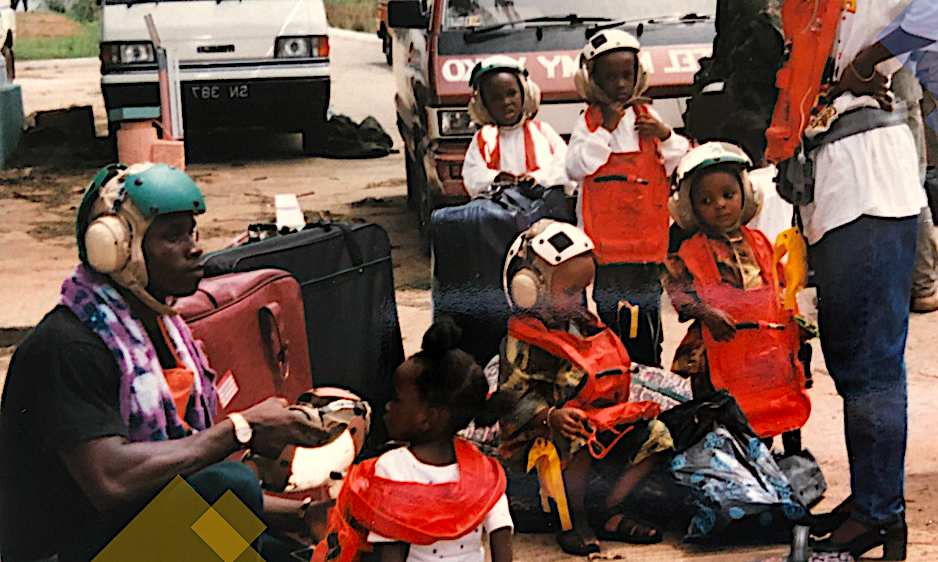
Family waiting for evacuation in Sierra Leone, 1997. (Ann Wright)
After evacuating all the U.S. citizens, diplomats, former government officials and U.S. diplomatic and local staff who had arrived at the hotel — over 900 from a crowd of several thousand — I was on the last helicopter to leave the hotel.
We knew there were several U.S. citizens who decided not to leave, including the manager of the hotel from which we were conducting the evacuation and members of several diplomatic missions who said they would remain open and ride out the coup, which was the third in the previous five years.
After we got those 900 persons aboard, the USS Kearsarge left Sierra Leonean waters and headed on the overnight voyage to Conakry, Guinea.
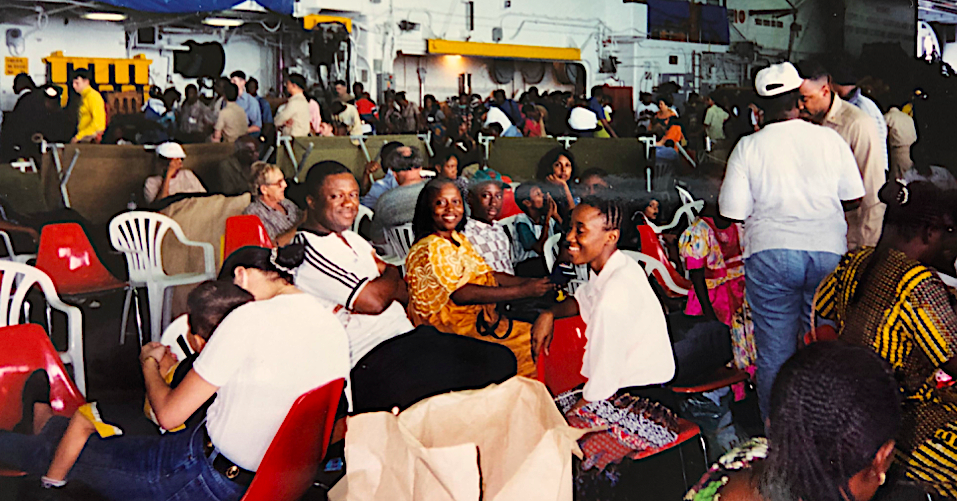
Evacuees from Sierra Leone inside USS Kearsarge in 1997. (Ann Wright)
Several consular officers from U.S. embassies in surrounding countries had been flown to the USS Kearsarge to help with the further processing of evacuees. As we got into helicopter range of Conakry, we began flying groups off the ship. First to fly off was our embassy consular and administrative staff — both U.S. and local — to help the U.S. embassy in Conakry with booking passage on commercial or chartered aircraft out of Guinea and on to family or friends in West Africa or Europe.
As we were beginning that movement, I got a call from the State Department in Washington saying that several U.S. citizens had arrived at the hotel after arduous and risky trips from the countryside after our last helicopter had flown out.
The State Department and Defense Department had decided that the USS Kearsarge would return to Freetown to pick up more evacuees, including young Sierra Leonean children from an orphanage operated by a U.S. citizen. We were told that all those who wanted to be evacuated were already at the hotel.
The captain of the USS Kearsarge and I discussed the capacity of the ship to handle more evacuees and the number of helicopter flights that we needed to offload sufficient people to Conakry, Guinea, to make room for the next group of evacuees. We kept steaming toward Conakry to get the helicopters within range and began sending helicopters filled with evacuees into Conakry. Then we turned and headed back to Freetown.

Orphans from Sierra Leone being carried onto the USS Kearsarge in 1997. (Ann Wright)
The orphans had arrived at the evacuation hotel with their U.S. citizen sponsor and several staff. The orphans had no birth certificates, no identification other than the names they were called as the sponsor said there was no time to collect any paperwork.
I was very uneasy about taking them to another country, especially since several of them appeared to be sick and might have a difficult time with the stress and lack of medical care for days upon arriving in Guinea, but the assistant secretary of consular affairs personally assured me that the U.S. government would work with the government of Guinea to let the orphans in without documentation.
On that second day of the evacuation, we quickly processed and flew more than 300 people out to the USS Kearsarge. In addition to the orphans, these were U.S. citizens and specific local government officials who felt their lives were in danger and had been able to get through the AFRC/RUF checkpoints.
For each day of the evacuation, I, along with security protection, went into the large crowd outside the perimeter of the hotel and looked for any remaining U.S. citizens.
As we left a second time, I spoke again with the U.S. citizen manager of the hotel, some members of the international community and Nigerian military who were at the hotel. They all said they were comfortable remaining in Sierra Leone.
As with the first day of the evacuation, we could not take thousands of Sierra Leoneans also hoping to leave.
With our new passengers, the USS Kearsarge turned and again began the trip to Guinea. Several of the baby orphans had to have medical intervention on the trip as well as later in Guinea.
Then, during the late evening, the hotel manager called the State Department operations center and said that the AFRC military had flown its helicopter gunship to the hotel and was firing into the hotel.
Part of the hotel was on fire and several persons, including a British soldier and several Nigerian soldiers, had been wounded by gun fire from coup ground forces who were coming onto the hotel grounds. On behalf of over 300 people in the basement of the hotel, he requested evacuation.
We immediately began helicoptering passengers to Conakry to make room for the next group of evacuees as we turned the ship back to Sierra Leone. During the night, the Marine contingent on the ship made plans for how we would handle the evacuation which we anticipated could be under gunfire.

U.S. Marines in Freetown, Sierra Leone, setting up a site perimeter on Day 3 of the evacuation. (Ann Wright)
We arrived offshore Freetown at dawn. From a helicopter above the USS Kearsarge, I watched as several huge hovercraft with giant rooster tails of water streaming behind them headed toward the beach near the hotel. The hovercraft drove up onto the beach, Marines disembarked with weapons and quickly constructed a large secure perimeter with concertina wire surrounding the road that paralleled the beach.
I was helicoptered in very quickly to decide who would be evacuated. I was the only U.S. diplomat remaining on the ship. Before Washington told us to go back to Freetown, I had sent the rest of the diplomatic staff to Conakry to help with the evacuation processing there.
Once the beach area was secure, we told persons inside the hotel to come in single file to an opening created in the concertina wire. We hoped the AFRC/RUF forces would not shoot them as they left the hotel. I personally checked the documents of each person very quickly and passed them on to the Marines who were putting people onto helicopters.
Now there was no time for helmets, life jackets or flight manifests. And no space for luggage. We instructed everyone to take their travel documents and medicines out of their luggage and leave everything else behind. Travel bags began piling up on the beach, as well as cars that had been driven by the few remaining members of the diplomatic corps in Freetown who had seen the helicopters coming back and decided it was time to leave after the AFRC attack on the hotel.
Immediate Decision Making
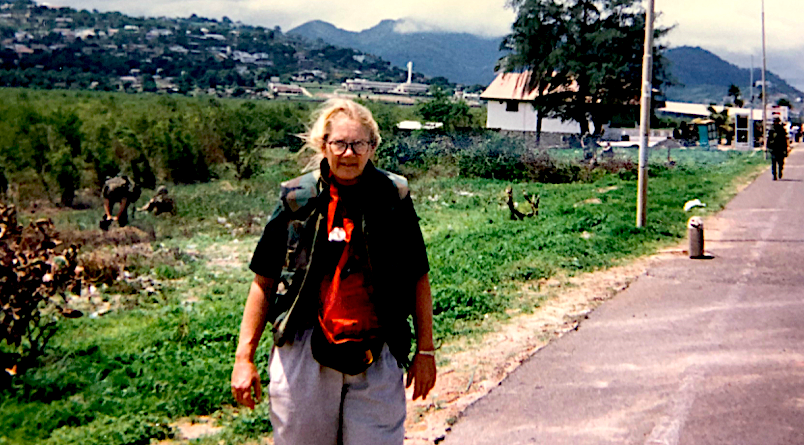
The author at the evacuation site on the final day, during the processing of 1,200 evacuees in four hours. (Ann Wright)
At one point, the lieutenant colonel Marine ground coordinator and his radioman came over to me and said he might have to suspend the flights. “Our air cap of fighter aircraft have spotted a group at the military headquarters walking toward the gunship that had fired on the hotel,” he told me. “We want your agreement that if the pilot gets into the helicopter, we will ‘disable’ the aircraft as the AFRC may have decided to stop the evacuation by firing on us.”
We had to make a decision that would protect those wanting to be evacuated as well as those who were conducting the evacuation operation.
In Kabul, by comparison, the U.S. military had to try to prevent another suicide bombing after the one on Aug. 26. There are reports that some Afghans may have been killed as U.S. soldiers fired their weapons in the immediate aftermath of the massive explosion that day.
Of critical importance in both cases was the location where possible military action would take place to ensure the protection of the evacuation.
In Sierra Leone we used military rockets fired from manned aircraft onto a military base at a helicopter with no civilians around.
That situation was in stark contrast to the use of an unmanned aerial vehicle, or drone, firing at a car reportedly filled with explosives and headed toward the Kabul airport to conduct another suicide mission while moving along a road filled with civilians.
As we know now, the car that was fired on from the drone was not on the road but had driven into a family compound. The car was surrounded by 10 people, including seven children, who should have been visible to the drone pilot and intelligence specialists who were remotely watching through the camera on the drone in real time in several U.S. military bases: in the Central Command Headquarters (Forward) in Qatar; Central Command headquarters in Tampa, Florida; the Pentagon and perhaps even from the White House.
Ten people were killed in the explosion, including three men who had worked for international organizations and seven children.
The U.S. military initially claimed that the car was destroyed in a secondary explosion that occurred after the intended, explosives-laden target car was hit by rockets from the drone. The U.S. military has suggested that the driver of the car may have been an ISIS supporter although members of the family strongly dispute that allegation.
We know from our work challenging the U.S. assassin drone program from 2001 onward in Afghanistan, Pakistan, Iraq, Yemen, Somalia, Syria and other countries, that many civilians who had no link with any terrorist group have been killed by these drones — people gathered for weddings, funerals, helping survivors of drone attacks or just going about daily life in their home compounds.
After helping to reopen the U.S. embassy in Kabul in December 2001, I have watched the unfolding events of the evacuation of over 124,000 people from the Kabul airport and have known, in general terms, some of the behind-the-scenes decisions that had to be made very quickly by diplomats and military people from many countries to get their citizens and Afghan colleagues out.
In 1997 we ended up evacuating over 1,200 people in four hours in the last day of the three-day evacuation. At the time, it was the largest evacuation since the U.S. withdrawal from Saigon.
We too were faced with a relatively sudden change of circumstances that one could classify as an “intelligence failure.”
We knew that the RUF was taking over more villages in the rural areas and we wondered why the Sierra Leonean military was not responding better to prevent RUF movements. We did not have specific information about elements within the military joining forces with the rebel group.
In Afghanistan, it was very apparent that the Taliban was taking more and more provinces with little resistance from the Afghan military and national police and that Taliban forces were going to be in the Kabul area long before the three-to-six-month prediction of U.S. intelligence agencies.
The decision to withdraw the remaining 2,500 U.S. military prior to dramatically increasing the number of American citizens and special immigrant visa holders and friends of the U.S. was a mistake.
A mistake, like the mistake of thinking military action in Afghanistan to go after Al Qaeda was the way to deal with terrorist actions. Also like the mistake of thinking that 20 years of occupation of a country was in either U.S. or Afghan national interest. This, after all, is a country whose indigenous forces have, over time, defeated other militarized empires for the past 500 years.
This was a lesson that was known but not respected by the U.S. politicians who heeded the corporations that are their campaign contributors and who know that war is profitable. Based on that lesson, they support wars instead of diplomacy to resolve political issues.
These same mistaken leaders are now trying to convince the American public that China and Russia must be dealt with as they increase dramatically the numerous of dangerous military naval, air and land war maneuvers that could lead to a worldwide nuclear catastrophe. We must continue to challenge these mistaken political leaders of our country and demand an end to the war mentality.
Ann Wright served 29 years in the U.S. Army/Army Reserves and retired as a colonel. She was a U.S. diplomat for 16 years and served in U.S. embassies in Nicaragua, Grenada, Somalia, Uzbekistan, Kyrgyzstan, Micronesia, Afghanistan and Mongolia. She resigned from the U.S. government in March 2003 in opposition to President George W. Bush’s war on Iraq. She is co-author of Dissent: Voices of Conscience.
The views expressed are solely those of the authors and may or may not reflect those of Consortium News.

Je préfère la démocratie populaire de Beijing à la démocratie bourgeoise de Washington.
La dictature populaire humaniste laïque éclairée de la Chine mène une gouvernance scientifique salutaire pour notre finalité humaine. La Chine recherche l’harmonie. “La porte de la paix céleste sur l’harmonie”
La dictature bourgeoise affairiste cléricale libérale Occidentale washingtonienne mène une gouvernance chaotique mortifère pour leurs finalités de cupidité, de marché et d’illusion (surtout en l’au-delà). Washington recherche la guerre. “Si tu veux la paix, prépare la guerre”
RE: “U.S. politicians who heeded the corporations that are their campaign contributors and who know that war is profitable.”
If those politicians who serve the for profit wars were voted out once and for all. If those U.S. intelligence services whose directive also serves those same corporations and war profiteers get shut down. If the full court press against the whistleblowers who serve the vast majority of people in this country by informing us of wrongdoing was ended. If we as a country decided to redirect our energy to fixing the wounds here at home and left the people of other countries to attend to their own wounds and manage their own natural resources. If we ended the too big to fail banks’ along with the IMF playing countries like they were pieces on a monopoly board to push around and drive into bankruptcy so they could pick up the pieces as they like to do.
If those ifs came true we’d be a different country and the world would be a safer, happier place.
But this will all end like Robert Frost told us in his poem Fire and Ice. Fire being nuclear war; Ice being climate catastrophe.
FIRE and ICE
BY ROBERT FROST
Some say the world will end in fire,
Some say in ice.
From what I’ve tasted of desire
I hold with those who favor fire.
But if it had to perish twice,
I think I know enough of hate
To say that for destruction ice
Is also great
And would suffice.
hxxps://www DOT poetryfoundation DOT org/poems/44263/fire-and-ice
Well said!
Thank you, Ann. If only our withdrawal from Kabul could have been handled as well.